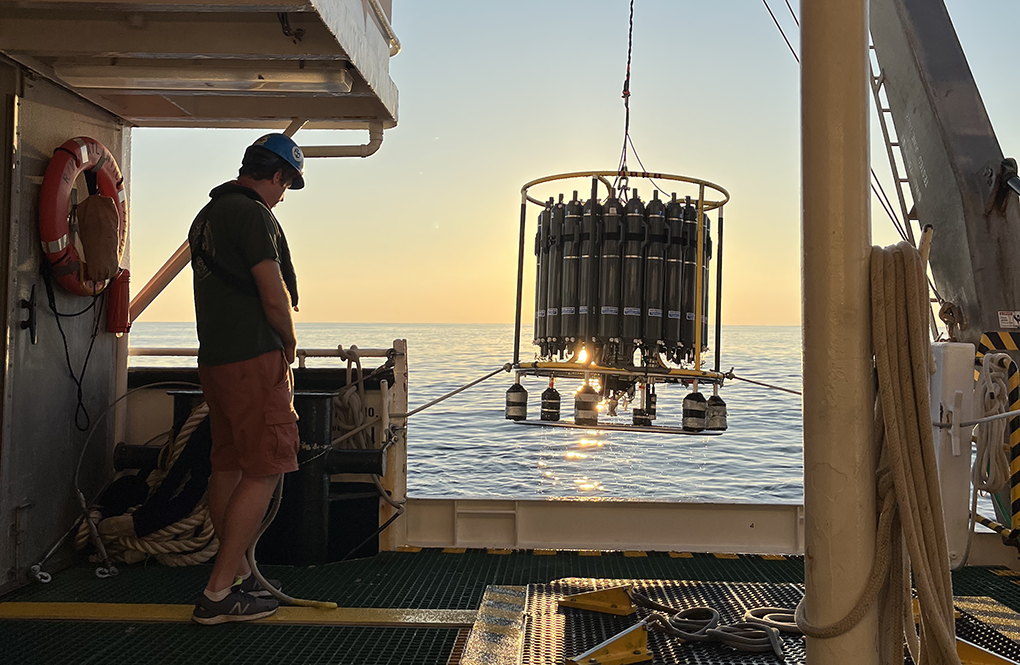Study Highlights Importance of Mineral Iron in Ocean Ecosystems

By University of Liverpool, August, 2023
New research published in Nature has revealed the importance of mineral forms of iron in regulating the cycling of this bio-essential nutrient in the ocean.
The findings pave the way for new work on the relationship between the iron and carbon cycles and how changing ocean oxygen levels may interact.
The study, led by the University of Liverpool and involving collaborators in the United States, Australia, France, and Bermuda addresses a knowledge gap in ocean research.
Principal Investigator Professor Alessandro Tagliabue said: “To date we have not fully appreciated the role that mineral forms of iron have played in driving the distributions and temporal dynamics of iron in the ocean”
The ocean of the early earth was low in oxygen and rich in iron, which was incorporated as a catalyst in many biological reactions. These include photosynthesis, which via its proliferation oxygenated the earth system. As iron is less soluble in well oxygenated seawater, precipitation and sinking of iron oxides led to iron levels declining. Consequently, iron now plays a critical role in regulating ocean productivity and hence ecosystems across the contemporary ocean.
It is thought that iron levels are largely regulated above their soluble thresholds by organic molecules called ligands, which bind iron. This view has underpinned the representation of the marine iron cycle in global models used to explore how changes in climate affect levels of biological productivity in the future.
However, oceanographers have been puzzled as to why there seemed to be a much larger loss of iron due to insolubility from the ocean than expected from the measured high levels of ligands. The ocean models built according to the expected pattern have generally performed poorly in reproducing observations.
This project, which was a process study contribution to the international GEOTRACES effort was jointly funded by the U.S. National Science Foundation and the UK Natural Environment Research Council and examined the processes driving the cycling of iron over an annual cycle for the first time.
It revealed that iron was largely cycling independently of ligands in the upper ocean and instead controlled by the clustering of iron oxide colloids to form so-called ‘authigenic’ particles that are lost from the upper ocean.
The authors developed a new numerical model to both explain their results and extrapolate their findings across the ocean. The new model performed markedly better in reproducing other independent observations and highlighted that this new process was important in around 40% of upper ocean waters.
A key implication is that this process occurs via the co-aggregation of iron oxides and carbon, which has implications for the global carbon cycle and may be sensitive to future trends of ocean oxygen loss.
“These findings will cause us to reassess our understanding of the iron cycle and its sensitivity to changing environmental conditions,” said Professor Tagliabue.
The University of Liverpool-led study also involved researchers from the University of South Florida, Oregon State University, Bigelow Laboratory for Ocean Sciences, Sorbonne Université, University of Tasmania, University of Leeds, the Bermuda Institute of Ocean Sciences, University of Georgia, and Old Dominion University.
Professor Tagliabue said: “Our work was only possible thanks to the efforts to measure multiple different forms of iron in seawater over the annual cycle at the Bermuda Atlantic Time-series site.”
Dr. Rod Johnson, co-principal investigator of the Bermuda Atlantic Time-series Study said, “the recent iron study in the BATS region lead by PI Peter Sedwick (Old Dominion University) is a successful integration of modelling and observational programs, advancing our understanding of the important role of iron cycling in the ocean and further, the modelling component led by Alessandro Tagliabue (University of Liverpool) highlights the strength of the BATS program in providing a robust framework for establishing new paradigms that can be evaluated at a local level and then upscaled for the global ocean.”
The paper, ‘Authigenic mineral phases as a driver of the upper-ocean iron cycle’, is published in Nature (DOI: 10.1038/s41586-023-06210-5).
Originally published on August 2nd in the University of Liverpool News.
